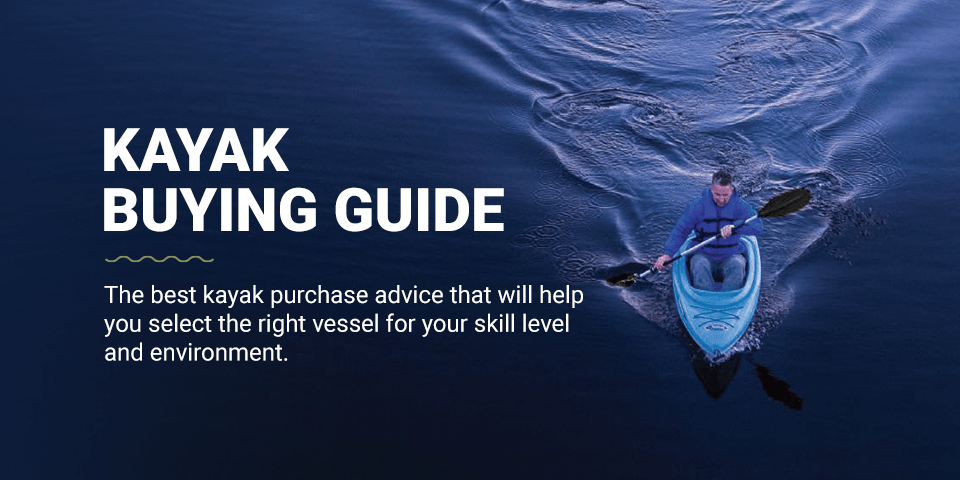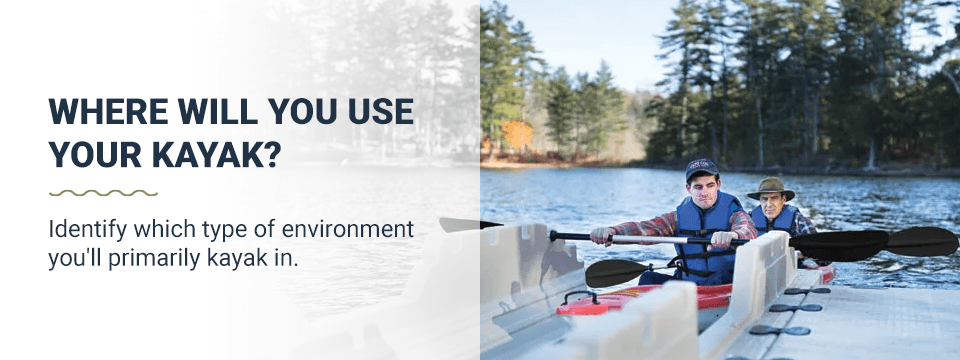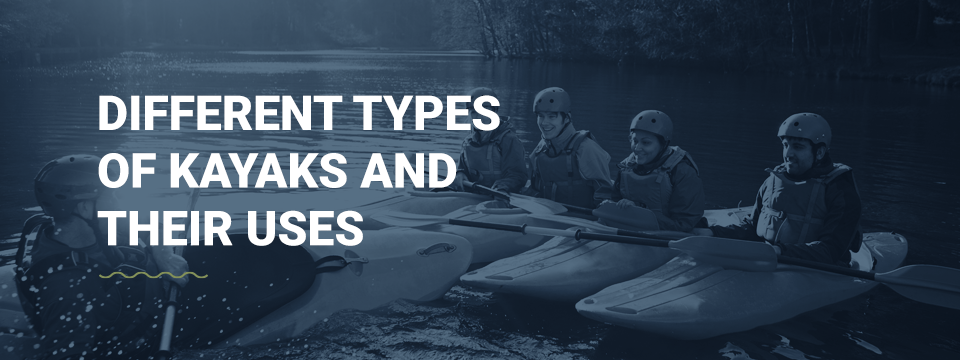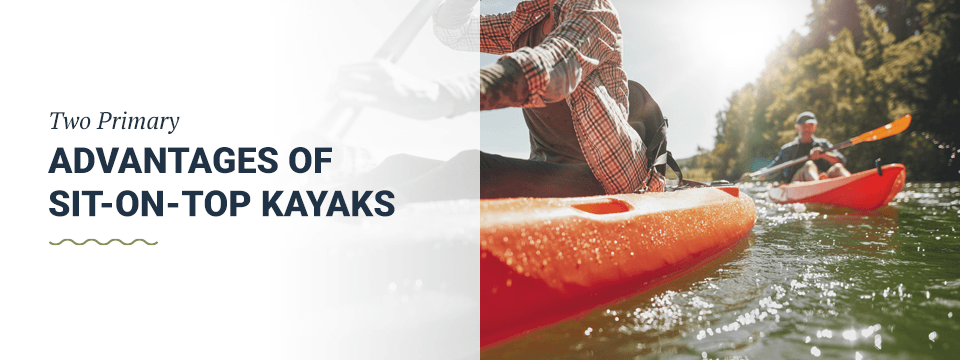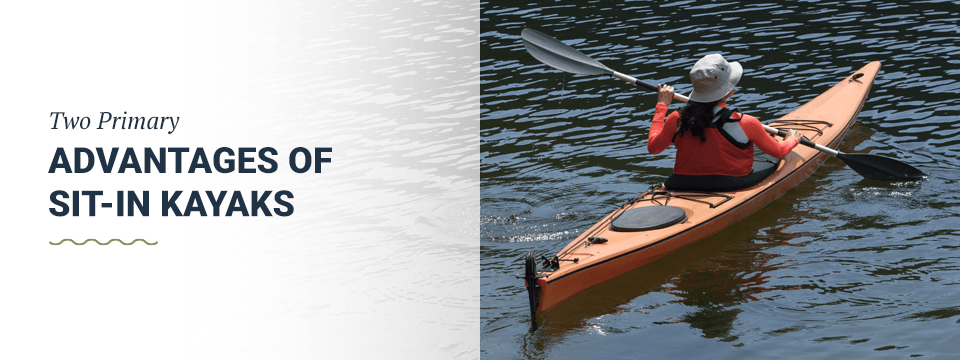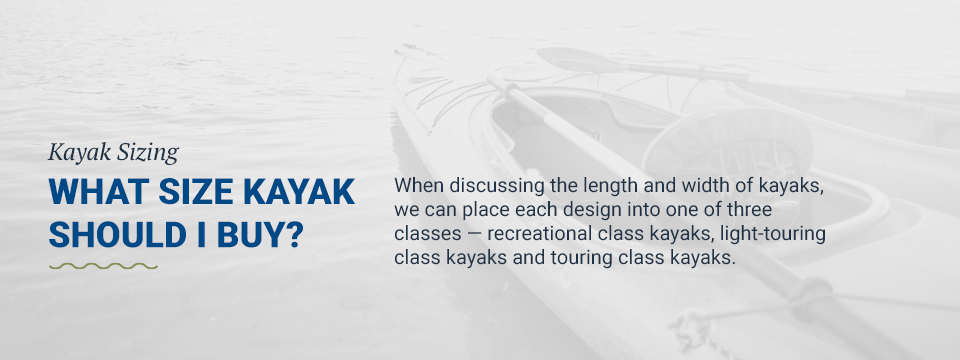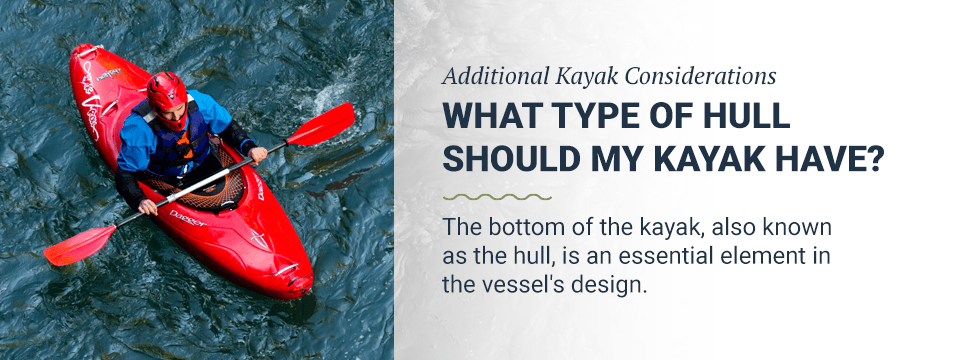Filters
Kayak Buying Guide from EZ Dock
Kayak Purchase Advice Based on Skill and Your Environment
Looking to purchase a kayak is thrilling — you’re taking steps to develop your hobby and you can finally own your own kayak. There are many different kayaks to choose from based on your skill level and the environment you plan on kayaking in, so choosing the perfect kayak involves some thought.
Consider how often you plan to be on the water and where you’ll paddle. What kind of experience are you looking for? Let’s look at some tips to help you find the best kayak.
Read the full article or jump to a specific section about buying a kayak for beginners:
- Where Will You Use Your Kayak?
- Different Types of Kayaks and Their Uses
- Kayak Sizing – What Size Kayak Should I Buy?
- Additional Kayak Considerations – Paddles, Hulls and Launching
- EZ Launch® Residential and Docking Considerations
Where Will You Use Your Kayak?
Before we discuss choosing a kayak, it’s necessary for you first to identify which type of environment you’ll primarily kayak in. Of course, all types of kayaks will float on any water surface. However, specific kayak models are designed for optimal use in certain environments. To put it in a different perspective, relate a kayak to a vehicle — although all types of cars can drive on a solid surface, you wouldn’t take a sports car off-road because it’s not designed to handle the terrain.
Kayaks are similar — they’re each designed to perform best within an intended environment. In a general sense, there are two types of water environments. An inland water environment includes smaller rivers, lakes, bays, inlets, ponds, canals and other smaller bodies of water. Open water refers to all other large bodies of water like oceans or seas and larger lakes or rivers. For instance, kayaking on a small lake, narrow river or open sea will each present you with a different experience:
1. Lakes and Ponds
If you’re after a calm and leisurely experience, your local lake will be perfect. Enjoy some quiet serenity, do some fishing or get some exercise. Something to remember — the larger the lake, the bigger the waves, so you may need a different kayak if you’re thinking of negotiating some white caps.
2. Rivers and Canals
These waterways can come in all shapes and sizes. Some rivers offer you a peaceful ride downstream, while others give you an adrenaline-filled experience battling through whitewater rapids. Regardless of your experience level, you should be aware that these waterways could change without warning. The speed and activity level of their currents, both on and under the surface, could drastically increase or decrease in an instant.
If you’re on a river, you’ll be more capable in a sturdy kayak that can turn instantly.
3. Seas and Oceans
Similar to rivers, the activity level of a sea or ocean can change with the weather. Though staying close to the coastline can make navigating this body of water slightly more manageable, varying factors like wind speed, tidal fluctuations and storms can create difficulties for kayakers at any distance.
Consider a fixed tracking fin on skeg — a fin you can put into the water when needed — to give you some extra maneuverability in choppier waters.
4. Rivers and Lakes
For negotiating both calm and flowing waters, you might need a more versatile kayak. Consider a crossover boat with a skeg to help with responsive steering. In general, longer boats have rudders, so it could take some searching, but a short boat with a rudder would also be an option.
Types of Kayaks and Their Uses
The type of environment isn’t the only factor you should consider when deciding on which kayak to purchase. How you plan to use your kayak is just as important. One perk of owning a kayak is taking it with you almost anywhere and exploring countless lakes, rivers, streams and seas. Try to envision your ideal kayaking excursion. Will you be relaxing or fishing? Do you plan on paddling great distances or racing others?
There are many different types of kayaks, and their uses range from light recreational paddling to intense whitewater rapid navigation. Before we break down these vessels into specific activity types, let’s look at kayaks in a general sense.
Sit-On-Top Kayaks
Sit-on-top kayaks have a seat on the kayak’s surface, so the paddler is above the water. Some benefits of these kayaks include:
- Self-bailing: As you kayak, your vessel may take on water. If water were to get into the cockpit of your sit-in kayak, you would have to bail it out yourself. A sit-on-top kayak, however, features scupper holes that automatically allow the water to drain.
- Better Mobility: One advantage of sit-on-top kayaks over sit-in kayaks is that the top deck seat gives you greater mobility. Inside of the cockpit of a sit-in kayak, you’re limited in how much you can move, which means you’ll have an extra obstacle when getting in and out of the water. A sit-on-top kayak lets you get in and out of the water quickly and easily.
- Extra cargo space: When you’re in a sit-on-top kayak, you’ll have space to store your belongings on the deck and inside the hull. Some models include rod holders. Others give you the option to add them when needed.
- Added weight: Sit-on-top kayaks are heavier, which can give you extra stability in the water.
Sit-In Kayaks
Sit-in kayaks have an enclosed cockpit that you sit inside, so the paddler sits below the water’s surface in the kayak. These are the benefits of sit-in kayaks:
- Greater control: Though both kayaks provide stability, a sit-in kayak will give you greater control. Along with your positioning, having your rear, knees and feet in contact with the kayak will help you maneuver more acutely.
- Dryness, warmth and sun protection: Because your entire body is outside a sit-on-top kayak, you risk getting wet. While this may be tolerable in warmer climates, those who want to kayak in colder climates or throughout the changing seasons may not want to increase their chances of getting wet. Sit-in kayaks keep the lower half of your body beneath the deck, limiting how wet you may get and your sun exposure. The cockpit also keeps you warm — shielding you from water, wind, rain and snow.
- Paddle efficiency: Sit-in kayaks are often more efficient to paddle, as your center of gravity is lower. Your kayak can be lower in the water and less bulky. The narrower the kayak, the more efficiently it will move through the water.
What types of kayaks are best for beginners? In the debate of sit-in kayaks versus sit-on-top kayaks, we recommend a sit-on-top for your first kayak. Sit-on-tops are generally more user-friendly than sit-ins. This kayak is easier to get into and out of, which is very helpful in emergency situations. You can exit a sit-on-top easily without needing to learn how to make a wet exit required for sit-in kayaks.
Now that we’ve covered the two different styles of kayaks, let’s look more closely at six common types of kayaks and their uses.
Recreational Kayaks
These sit-in kayaks have a larger opening that makes it slightly easier to enter and exit compared to the compact seating of a touring kayak. Short in length, most recreational kayaks reach about 10 feet long. They aren’t built for speed, but they do provide the stability needed for a leisurely trip and are ideal for short trips through calm waters, including:
- Lakes.
- Slow-moving rivers.
- Ponds.
- Quarries.
A recreational kayak is an excellent sit-in kayak for beginners. Its open cockpit doesn’t feel confined, and many can also fit an adult and a small child inside. Though they don’t track as well as a touring kayak, they are easy for a novice kayaker to maneuver. If you prefer a sit-in kayak to a sit-on-top kayak, we suggest choosing a recreational kayak that is accommodating for kayakers of all ages and skill levels.
Touring Kayaks
Also referred to as sea kayaks, these vessels are typically sleeker than standard recreational kayaks. They are narrow and long, usually a minimum of 12 feet in length. The cockpits of these kayaks are also more compact so that the kayaker can use their hips and thighs to roll themselves over if they capsize. Touring kayaks are built for speed and distance.
Kayakers often use them for:
- Ocean trails.
- Extended journeys, like multi-day excursions.
- River racing.
A touring kayak can be an exciting way to navigate large bodies of water. If you’re close to an ocean, river or lake launch point, you could get extensive use out of a touring kayak. However, beginners may have a slightly harder time learning on a sea kayak than other recreational variations. This is also not an ideal kayak for families or solo kayakers who want to paddle around a pond or stream leisurely. For beginners, smaller kayaks are more forgiving.
Whitewater Kayaks
Whitewater kayaks are for more aggressive forms of kayaking. There are four types of whitewater kayaks — playboats, river runners, creek boats and long boats. Playboats are as short as 6 feet in length and should be used on standing waves and holes in a rapid, not for traveling down a river. River runners are slightly longer and can endure a trip down the river. Creek boats are longer and heavier than river runners to withstand drops.
Longboats can be 12 feet long and are ideal for:
- River rapids.
- Narrow, fast-moving water trails.
- Local park waters.
Depending on the types of rapids you wish to take on, you should consider the length and durability of each of these kayaks. If you’re a beginner, a whitewater kayak may not be ideal for your first purchase. While all water-based activities have risks, whitewater kayaking is an adrenaline rush for more experienced kayakers. Choose and master a sit-on-top or recreational sit-in kayak before moving on to this advanced vessel.
Inflatable Kayaks
The number one benefit of an inflatable kayak is that it can be stored and transported much easier than any other kayak variation. Inflatable kayaks are perfect for those living in smaller areas like apartments or needing to store their kayak conveniently when not in use. These kayaks function like all other kayaks, making them just as susceptible to damage or capsizing. Inflatable kayaks are available in flatwater and whitewater designs.
Some popular places for inflatables include:
- Whitewater rivers without excessive rocky terrain.
- Ocean waters.
- Lakes.
As a beginner or someone who may not use a kayak as heavily as someone who spends every weekend paddling, an inflatable kayak has numerous advantages. First and foremost, it’s convenient to store or transport which means that those who may not have constant access to a body of water or the available time to kayak frequently can easily place it on a shelf and keep it out of the way. It’s also an ideal option for families who will only use their kayak on vacations.
Fishing Kayaks
If you’re an avid fisherman, you may consider purchasing a fishing kayak. Some features these types of kayaks may include are rod holders, pedal propulsion systems that can be motorized and extra cargo storage. Though most prefer a sit-on-top kayak, there are also fishing kayaks that are sit-ins. These kayaks can also handle more weight than other recreational varieties, helpful if you plan to haul gear and keep your catch.
You can use a fishing kayak on:
- Fishing ponds.
- Small, mid-size and large lakes.
- Calm rivers.
Learning how to pick the right kayak can be tricky, especially if you plan on using a kayak for fishing purposes. If you casually fish but plan on using your kayak more for leisure than for sport, we don’t recommend purchasing a fishing kayak right away. Instead, it may be better to opt for a general recreational kayak, like the kind mentioned above. However, suppose you are buying a kayak specifically for fishing. We recommend you look for one that can carry your gear, handle your environment and provide you with the mobility you need.
Tandem Kayaks
There are many types of kayaks for beginners but those learning to kayak with a friend, family member or partner may opt to purchase a tandem kayak instead of a single-seater. There are a few advantages to buying a tandem kayak. For instance, a larger-sized tandem kayak allows for more storage. However, one challenge is that the increased weight of a tandem kayak makes it more difficult to recover when capsizing.
The best type of kayak for beginners may be a tandem kayak if you’re planning on kayaking with a partner frequently on calm and contained waters, such as:
- Quiet ponds.
- Small lakes, away from ramps or busy areas.
We would not suggest this type of kayak if you want to paddle solo or plan on learning on rough waters like rivers or seas.
Kayak Sizing — What Size Kayak Should I Buy?
Kayaks can range from 6-16 feet in length, but your average kayak size is about 10 feet. In most cases, shorter kayaks are more stable, and longer kayaks can go faster. Stable options are better for beginners, as they help you keep your balance while you’re learning. When choosing a kayak, use the three classes to determine the right size:
- Recreational class: These kayaks are less than 12 feet long and over 24 inches wide. They typically weigh less than 50 pounds and provide excellent stability.
- Light-touring class: These kayaks will range between 12 and 16 feet long. Their width will also vary, falling in the 22- to 25-inch range. Their added length and width will increase their weight. Light-touring kayaks are fitting for amateur kayakers who enjoy both sport and leisure.
- Touring class: These kayaks are longer than 16 feet in length and will have a width of 22 or fewer inches. Kayakers use touring class kayaks for more advanced excursions or weather conditions.
The length, width and weight of your kayak impact its capabilities in the water. For instance, small and wide kayaks provide more stability, while long and narrow kayaks are faster. Along with speed and maneuverability, you must consider factors like storage capabilities, transportation concerns and sizing. Ask yourself these questions:
1. How Important Is Kayak Speed?
Instead of rating the kayak on its speed, consider what kind of kayaking experience you desire. Do you want to traverse large distances or stay in a contained spot? Is getting to your destination quickly the goal or do you prefer to enjoy the journey? A recreational kayak will suffice if you’d prefer to paddle around your favorite fishing spot. A touring or light-touring class kayak is better if you want to race downriver or make it miles down the shore.
If you’re buying a kayak for the first time and still racking up experience in the water, consider kayaks that focus more on balance than speed. As you gain experience, you’ll become comfortable with faster options.
2. How Important Is Kayak Maneuverability?
The ability to maneuver your kayak is just as important as the speed. Consider the environment you’ll primarily kayak in. Open rivers, lakes and the sea have fewer obstacles than small creeks and ponds. Recreational kayaks are small enough to move around in the narrowest waterways, but touring and light-touring kayaks suit open water, as you won’t have to make sharp turns or negotiate sudden changes in direction.
3. How Does Your Size Compare to the Kayak’s Size?
Safety should be your primary consideration when purchasing a kayak, regardless of what features are most important to you. Be sure that when you board your kayak, it can handle your weight and you’re capable of operating it effectively. Recreational kayaks are best for children and small adults, while light-touring and touring kayaks may be more comfortable for larger adults.
Your kayak shouldn’t be too tight. You need to be able to move freely and exit in emergencies unencumbered.
4. How Will You Transport and Store the Kayak?
Touring kayaks could present a challenge in the storage and transport department. Recreational or inflatable kayaks are more accommodating on both accounts.
The lighter the material, the easier it is to store, transport and load your kayak. Popular materials to choose from include:
- Polyethylene plastic: This material is heavy, but it’s relatively inexpensive and hardy. If you choose a polyethylene kayak, store it out of direct sunlight to prevent damage.
- ABS plastic: ABS is a little more expensive but just as durable as polyethylene. It’s lighter and more resistant to UV damage.
Consider whether you can carry your kayak and manage it yourself and how much gear you want to take with you. A lighter kayak means you can carry more.
Additional Kayak Considerations: Paddles, Hulls and Launching
Once you have an idea of the size, weight and maneuverability of your ideal kayak, turn to more detailed considerations. Things that seem less noteworthy, like paddle length and the type of hull, can impact your overall experience.
1. What Type of Kayak Paddle Should I Buy?
After identifying the things to look for when buying a kayak, the next step is to select a paddle. Without a good paddle, your kayaking experience may be less than ideal, so it’s important to take the time to identify the right paddle size for you. Choosing a paddle is easier than you might think.
Know that most people measure paddle size in centimeters, not inches. Accurate measurements are critical to ensuring that you don’t accidentally end up with a paddle that’s too short or too long. You can find out your ideal paddle length without leaving your house — measure your torso. Your measurement will most likely be in inches, but you can convert them to centimeters with ease using a kayak paddle size chart. Here’s how:
- Find a chair with a flat surface and grab your tape measure.
- Sit evenly on your chair with a straight back.
- Use your tape measure from your crotch to the tip of your nose.
- Measure again to confirm the length and compare your torso height to a standard paddle length chart.
Consider these torso heights and equivalent paddle lengths:
- 22 inches = 180 centimeters
- 24 inches = 180 to 200 centimeters
- 26 inches = 190 to 200 centimeters
- 28 inches = 200 to 220 centimeters
- 30 inches = 210 to 230 centimeters
- 32 inches = 220 to 240 centimeters
- 34 inches = 230 to 250 centimeters
- 36 inches = 240 to 250 centimeters
If you don’t have a tape measure, there are other ways to determine appropriate kayak paddle length. If you can rent a kayak or borrow one from a friend, you could test their paddle out right in the water and gauge how it feels. You should be able to tell right away whether it’s too big, too small, or just right. Alternatively, you can complete an even quicker option on land: Grab the paddle and hold it over your head or stand it upright next to you.
- Measuring the paddle when resting vertically: The first joints of your fingers should rest over the blade’s edge when reaching to the top of the paddle.
- Measuring the paddle while holding the paddle horizontally over your head: With bent elbows, your hand should be midway between the center of the shaft and the shoulder of the blade.
There are other factors to consider when choosing a paddle. The differing sizes of each kayak could slightly skew your measurements. The depth of the seat or the width of the vessel may require a shorter or longer paddle depending on your comfort level. Always test a new paddle in your kayak if you can, so you can be sure it’s a comfortable fit.
2. What Type of Hull Should My Kayak Have?
The bottom of the kayak, also known as the hull, is an essential element in the vessel’s design. The hull’s shape impacts the kayak’s performance, with each style lending advantages like stability, speed or maneuverability. Gathering knowledge about the capabilities of each hull is crucial to learning how to buy the right kayak. The four basic hull types are:
- Flat: The flat hull is one of the best for beginner kayakers. It is easy to manage and maneuver, giving the kayaker stability in calm water conditions. A flat hull is great for those who may be learning to kayak or fishers who are transitioning from a boat to a kayak.
- Rounded: The rounded bottom will allow the kayak to tilt in either direction, making it an ideal choice for the rougher waters of a river or an ocean. It’ll also help increase your speed and maneuverability. In calmer waters like quiet lakes or streams, this hull type will actually seem less stable and is not suggested for someone looking for a leisurely kayaking experience.
- V-shaped: A V-shaped hull has a rounded point at its bottom and is often tricky for beginner kayakers to manage. It will help increase the speed of kayakers going in a straight line, however, it won’t provide the same maneuverability as a rounded hull.
- Pontoon: The pontoon hull is the ideal hull for beginner kayakers. It provides the most stability and will be the easiest for novice kayakers to stay upright. Although it isn’t intended for more advanced or involved kayaking, pontoon hulls are great for a leisurely kayaking experience.
3. How Can I Make Launching Easier?
Kayak launches simplify entering and exiting your vessel by keeping it secure and steady. Some popular types include:
- Drive-through: Drive-through launches give users access to their kayak from either side of the launch with aluminum rails extending over the water. EZ Dock has small and large drive-through launches available.
- ADA accessible: Drive-through ADA launches work with other ADA-accessible products from EZ Dock, including the ADA Transfer Bench System. These models give extra stability for older adults and kayakers with disabilities to enter and exit independently.
- One-way: One-way launches have an aluminum railing extending over the water, letting you push away from the launch.
4. What Else Do I Need to Know?
There are a few other points to consider before making your final decision. Check the following specifications and ensure they suit you and your kayaking goals:
- Hatches: Consider how much storage space you’ll need. Some larger kayaks have two hatches — smaller vessels have one.
- Weight capacity: Combine the weight of your gear, your boat and yourself for weight capacity needs. Stay within your kayak’s weight capacity or you’ll sit too low in the water, making you less efficient.
- Length and depth: Longer boats are more efficient cruisers, and shorter ones turn better. Consider how much maneuverability and storage space you need. Deeper hulls give you more legroom and storage, but shallower ones are more resilient in the wind.
- Width: The wider your kayak, the more stable you are. Narrower vessels are faster.
- Rudders, tracking fins and skegs: These attachments help your kayak track straighter in the wind. They can prevent you from blowing off course.
- Cockpit size: Large cockpits are easy to get in and out of, while smaller ones give you better control and protect you from the elements.
EZ Launch® Residential and Docking Considerations
Once you’ve got your kayak, paddle, lifejacket and swimwear, it’s time to hit the water. Some kayakers are fortunate enough to have direct access to a shoreline that allows them to drag their vessel into the water and paddle away. However, many waterfronts don’t always have a reliable, safe or accessible shoreline to launch your watercraft. EZ Dock wants to help you access any body of water safely and efficiently which is why we’ve created the EZ Launch® Residential that caters to kayakers of all skill levels.
Our floating EZ Launch® Residential makes getting in and out of the open water a breeze. We believe that mobility issues should not prevent a kayaker from enjoying the water. Along with a surface that’s slip-resistant and splinter-proof, the EZ Launch® Residential maximizes accessibility for kayakers of every age and ability. This platform exceeds ADA requirements so any individual can easily use the side rails to lift themselves out of or lower themselves into the kayak with ease.
The EZ Launch® Residential is an innovative and inclusive floating dock that rises and falls with the water level, ensuring that you can always access the water. Its integrated paddle notches, wide format and V-shaped entry provide kayakers with the confidence and stability they need to safely, securely and independently launch the vessel. With an EZ Launch® Residential system on your waterfront, nothing will stand between you and the open water.
For more information about the EZ Dock EZ Launch® Residential or any EZ Dock products, let one of our friendly team members answer all of your questions.

